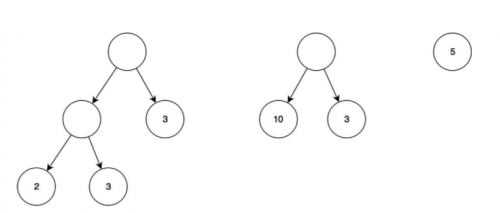Recursive binary tree and sum of leaves
Friends I'm having trouble solving this exercise, and I don't know how to do it anymore. I got to implement the tree with recursion, but I could not leave the node empty and some sheets with number, as the exercise. Next I need to add up the items that are on the sheets.
No.java
public class No {
public int valor;
public No direito;
public No esquerdo;
public No(int valor) {
this.valor = valor;
}
}
ArvoreBinaria.java
public class ArvoreBinaria {
private No raiz;
public void inserir(int valor) {
if (raiz == null) {
raiz = new No(valor);
} else {
No novo = new No(valor);
inserir(raiz, novo);
}
}
private void inserir(No arvore, No novo) {
if (novo.valor > arvore.valor) {
if (arvore.direito == null) {
arvore.direito = novo;
} else {
inserir(arvore.direito, novo);
}
} else {
if (arvore.esquerdo == null) {
arvore.esquerdo = novo;
} else {
inserir(arvore.esquerdo, novo);
}
}
}
Exercise
- Uma árvore tem nós; - Um nó pode ou não ter outros nós; - Um nó, não folha, tem sempre um nó do lado direito e outro do lado esquerdo - As folhas não tem nós abaixo; - As folhas têm associado um número inteiro
The following figure represents 3 instances of trees binary
We intend to implement an algorithm in Java that allows instance construction of this type. You should have a method that returns the sum of the tree, i.e. the sum of the leaves.
Tips:
- a node, not a leaf, always has a node on the left and a node on the right
- after the construction of a node, it will be possible to add other nodes
- Recursion
- do not use Java type complexes (
HashMaps,Lists and etc)
1 answers
Here goes your binary tree class. I added in class No and Class ArvoreBinaria the methods soma(). I also put the toString() to be able to show the structira of the tree.
class ArvoreBinaria {
private No raiz;
public void inserir(int valor) {
if (raiz == null) {
raiz = new No(valor);
} else {
No novo = new No(valor);
inserir(raiz, novo);
}
}
private void inserir(No arvore, No novo) {
if (novo.valor > arvore.valor) {
if (arvore.direito == null) {
arvore.direito = novo;
} else {
inserir(arvore.direito, novo);
}
} else {
if (arvore.esquerdo == null) {
arvore.esquerdo = novo;
} else {
inserir(arvore.esquerdo, novo);
}
}
}
public int soma() {
return raiz == null ? 0 : raiz.soma();
}
@Override
public String toString() {
return raiz == null ? "*" : raiz.toString();
}
private static class No {
private int valor;
private No direito;
private No esquerdo;
public No(int valor) {
this.valor = valor;
}
public int soma() {
return valor
+ (direito == null ? 0 : direito.soma())
+ (esquerdo == null ? 0 : esquerdo.soma());
}
@Override
public String toString() {
return (esquerdo == null ? "*" : "(" + esquerdo + ")")
+ valor
+ (direito == null ? "*" : "(" + direito + ")");
}
}
}
Here is a test class:
class Teste {
public static void main(String[] args) {
ArvoreBinaria ab = new ArvoreBinaria();
System.out.println(ab);
ab.inserir(5);
System.out.println(ab);
ab.inserir(10);
System.out.println(ab);
ab.inserir(15);
System.out.println(ab);
ab.inserir(2);
System.out.println(ab);
ab.inserir(4);
System.out.println(ab);
ab.inserir(6);
System.out.println(ab);
ab.inserir(8);
System.out.println(ab);
ab.inserir(20);
System.out.println(ab);
System.out.println(ab.soma());
}
}
Here is the output:
*
*5*
*5(*10*)
*5(*10(*15*))
(*2*)5(*10(*15*))
(*2(*4*))5(*10(*15*))
(*2(*4*))5((*6*)10(*15*))
(*2(*4*))5((*6(*8*))10(*15*))
(*2(*4*))5((*6(*8*))10(*15(*20*)))
70
Note from the output that the tree is being assembled as expected and that the sum is also correct.
See here working on ideone.
